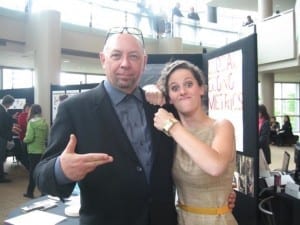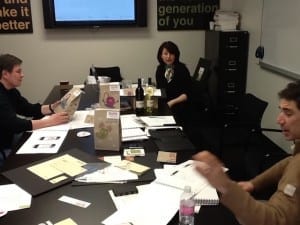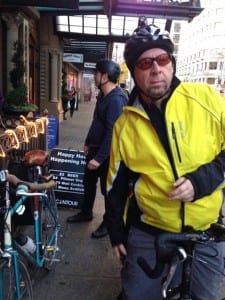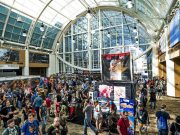
There has been a growing recognition in the last 25 years that design creates value for business. Nowhere is that more true than in the online environment.
As marketing plans shift from global to niche strategies, designers are being asked to participate in crafting both overall user experience and micro-targeted, persona-based engagements. In each case, designers are being given early seats at the strategy table.
How can the new breed of multi-channel, multimedia graphic designer be best prepared to enter the conversation?
How can a designer learn to integrate an overarching, brand-affirming strategy while also activating user conversions and other key performance indicators?
Under the stewardship of Doug Heinlein, the Art Institute of Seattle (AiS) has responded to market challenges with characteristic Northwest aplomb.
The AiS campus curricula is as multi-faceted as the online medium itself, not only teaching students the basics of design and preparing them for the marketplace, but allowing them to explore their own creative approaches with a number of course options that draw upon their individual interests and strengths.
“We don’t over-prepare specific technical skills,” relates Heinlein. “Those will invariably change from year to year. We want to teach students how to think, adapt and create.”
Here’s how the charismatic Director of the AiS School of Design traded the “L Trains” in the city of Chicago for the ferry lanes of the Puget Sound and is changing the way his students visualize next generation design solutions. Is the program working? The placement of AiS graduates at Seattle’s leading tech companies reads like a LinkedIn “Who’s Who.”
Seattle24x7: Welcome, Doug. How would you describe your responsibilities as Director of the AiS School of Design? What do you enjoy most about your role?
Doug Heinlein: I handle day-to-day operations, student success, curriculum development, hardware/software and physical plant budgeting and faculty hiring and assignments at AiS for the Graphic and Web Design program. I was originally hired in 2003 as head of the Multimedia and Web Design program and about 6 months later also came to lead the Graphic Design program. I also teach every quarter, typically in Information Architecture and Usability as well as Portfolio courses, although this can vary.
I really enjoy Design Production Team class. Last year we had four competing teams of students envision a new approach to marketing the Emerald City Comicon. We invited principal Jim Demonakos to review their ideas and he was so impressed he brought back with him staff from the Bullseye Creative team to see the students’ final presentations. But the real highlight is working one-on-one with students and helping them refine their vision. Seeing them move on to their professional careers is a delight, and I am in contact with many graduates years following graduation through social media.
Seattle24x7: Are AiS graduates succeeding in landing local positions?
Doug Heinlein: I recently received a career update from a former student saying he was moving on to Assistant Art Director at Apple so I did a quick survey of where former students were working. I was so impressed I pulled about 35-45 profiles and compiled them into a .pdf file to share with staff and current students.
Our program and students are second-to-none. My former students are at Microsoft, Amazon, Deloitte Digital, 206, Starbucks, Nordstroms, BMG, Apple, Linkedin, Apex Learning, Methodologie, Substantial, Wizards of the Coast, Adobe, Boeing, and hundreds more agencies, big and small. Google remains a challenge for us…we’ve had two graduates interview there and gone deep into the process but didn’t have the engineering background or computer science degree for the particular posts.
Seattle24x7: How has the design curriculum evolved since you began in the field?
Doug Heinlein: At my last position in the field as Director of Design for a small interactive agency in Chicago called closerlook. Inc., during the late 1990’s-early 2000’s, we were challenged with bridging traditional design practices with breaking technologies. Talented graphic designers were asked and tasked with developing visual solutions for web-based businesses with no practical experience in coding or web grid systems, and usability was just beginning to make a dent in business strategy decisions.
We had to learn how designers could talk with engineers (and vice versa) in developing strong solutions, and it was a difficult time for both disciplines. Through the blog A List Apart and reading Bob Jacobson, usability and experience design became a central theme in design. AIGA began running conferences under the moniker Advance for Design and I attended the Telluride, CO summit in 2000 and got great insights from Hugh Dubberly, Clement Mok, Chris Edwards and many others as to how to approach and solve this issue. When I accepted the lead for both Web Design and Graphic Design departments in 2004 the opportunity arose to blend the disciplines into a hybrid designer, anticipating the needs of the marketplace.
Seattle24x7: Sounds like an interdisciplinary challenge?
Doug Heinlein: I wrote a blended Bachelor degree curriculum which became a national model for the Art Institute family of schools. This curriculum included traditional graphic design skills and expanded with sequential thinking, motion graphics, coding for both disciplines of course, usability and user testing as well as a strong component of interdisciplinary teamwork directed at visual storytelling and problem solving. Our placement rates and starting salaries have been leading the school for the last ten years, and even through the recession our students found jobs upon graduation. Many were working already while finishing up their final quarters.
Seattle24x7: How does the AiS trajectory compare with other design schools?

Doug Heinlein: We are tasked with preparing students for an entry-level job in their technical field of choice. As a Bachelor degree program we also prepare students for life long learning. This means that not only should they be competent in the tools and language of design but be prepared for deep research and critical thinking.
We are able to adjust quickly to changes in technology as they develop in the marketplace so currently we are incorporating the maker movement, 3D printing and interface and usability concepts in relationship to the changing mobile technologies. We would like to explore AR and haptics but we already are trying to pack a 5 year design degree into 3 or 4 years. For everything we add something has to be cut. We try to impress students with the fact that they will need to evolve and change constantly throughout their careers.
Seattle24x7: Is there a particular approach or design philosophy to UI/UX in game design or web design that AiS espouses? Do you have a personal philosophy of UI/UX that you can share?
Doug Heinlein: We share many of the aspects of UX design as seen in today’s market including Lean UX principles and the Agile development process.
As far as a personal philosophy, I would say I would subscribe to the concept that not only the experience be useful but, even more importantly, be delightful. There are many examples but I think watching TurboTax grow and develop over the years you can see them trying to make tax preparation not only useful but an engaged and delightful experience…not all would agree it’s a success, but I like what they are attempting.
I think back to the early web days and designers were pretty much being pushed around by coders, we tried to voice concerns over technology solutions but were ignored, we just “applied the lipstick.” It was hard to get the budget to have a designer sit in on early strategy client meetings and it took many years for UX to gain a voice in business strategy decisions.
When Microsoft decided to include the concept as a core business goal the rest of industry followed their lead. MS had usability testing of course for years but if you go back and review some of the material you’ll find all kinds of justifications (How much does it cost? Why should I care?) for what now would be considered standard business practice.
It’s been an incredible last 20 years for the design field, and a sea change in the definition of what it means to be a designer in today’s world.
Seattle24x7: You have a strong background in multimedia and gaming. Any particular firms or projects you’d like to mention?
 Doug Heinlein: Well I’ve had a pretty good go at it…during my storyboarding days after grad school doing TV commercials and animatics I was able to view my work with families and friends on screen. I had done the boards for an Oldsmobile campaign and these were being displayed Jumbotron style at the Chicago Auto Show – I’ve had had projects that were just killed midstream also…such as a project I did with Sierra OnLine and AT&T called Cyberpark that really was similar to Second Life but 10 years too soon…but I’ve had wins as well, such as working on breaking technology with a small Seattle company named Progressive Networks (now Real Networks of course) pioneering streaming audio and video- so I guess I had a Seattle connection earlier than I thought…back then it was as muddled with technology as it is now, no one knew who would win out.
Doug Heinlein: Well I’ve had a pretty good go at it…during my storyboarding days after grad school doing TV commercials and animatics I was able to view my work with families and friends on screen. I had done the boards for an Oldsmobile campaign and these were being displayed Jumbotron style at the Chicago Auto Show – I’ve had had projects that were just killed midstream also…such as a project I did with Sierra OnLine and AT&T called Cyberpark that really was similar to Second Life but 10 years too soon…but I’ve had wins as well, such as working on breaking technology with a small Seattle company named Progressive Networks (now Real Networks of course) pioneering streaming audio and video- so I guess I had a Seattle connection earlier than I thought…back then it was as muddled with technology as it is now, no one knew who would win out.
Things are always changing, from animated GIFs to Future Splash to Flash to HTML5 and javascript, from PageMaker to Quark to InDesign…everything keeps evolving. It’s damn exciting to be part of.
Seattle24x7: What was most attractive to you about the Pacific Northwest
Doug Heinlein: Of course, I was aware of something called the “Pacific Northwest” and cities such as Seattle and Portland, but these places were “over there” and “somewhere on the west coast.”
I flew in initially to do a meeting with Cobalt Group in December 2002 and I recall distinctly that Seattle was warm (it was something like -19 in Chicago and 45 degrees in Seattle)!
I found the city was like a weird combination of San Francisco and Cleveland – a town I grew up near. I loved the natural beauty and steep hills but even more so the grit of a working city with railroads, docks, and work cranes along its waterfront. I fell in love immediately. At that time, Pioneer Square was a bit more gritty, and that appealed to the motorcycle rider side of me as well. Now, of course, that old grit of has a smooth glassy sheen of cloud computing over it.

Seattle24x7: Your weekday commute to Seattle is over water by ferry and over land by bicycle, wonderfully “off the grid.” How different is this life & work-style from your early agency experience in Chicago? Is this part of the NW experience something you relish?
Doug Heinlein: It really is. I commute by bicycle now, rain or shine, and nothing beats the bicycle road home after a long day at work. In Chicago, I had to drive to a train, sit in crowded commuter train cars, suffering someone’s cheap cologne, and then walk a mile or so to work every day. Now I can hop on the bike and pedal away. I’ve developed a great ferry community of friends as well by taking the boat from Bainbridge Island, and commute time is a little shorter as well. There is really no comparison and we are so blessed to be living here. With the national success of the Seahawks, I think the rest of the country is finally getting a better idea of what it’s like here.
Seattle24x7: What did we forget to mention or inquire about your design and multimedia outlook?
Doug Heinlein: Probably something like “How did a kid from a small town in Ohio who wanted to be a fine artist, a painter, end up in interactive media?” It’s a long story with lots of twists but I think underneath it all is the power of a broad, liberal arts education. I am quite wary of making higher education narrowly targeted to career and employment statistics. We know that a given adult may have two or three careers by their retirement — maintaining the integrity of the definition of a Bachelor’s degree, learning how to learn, how to stay inquisitive, how to do research. That education has been a key to my own ability to reinvent myself over the course of my career. The freedom to make mistakes, learn from mistakes, or incorporate them into a new discovery or solution is vital. I hope it is never lost. [24×7]
Visit the Art Institute of Seattle online.

















